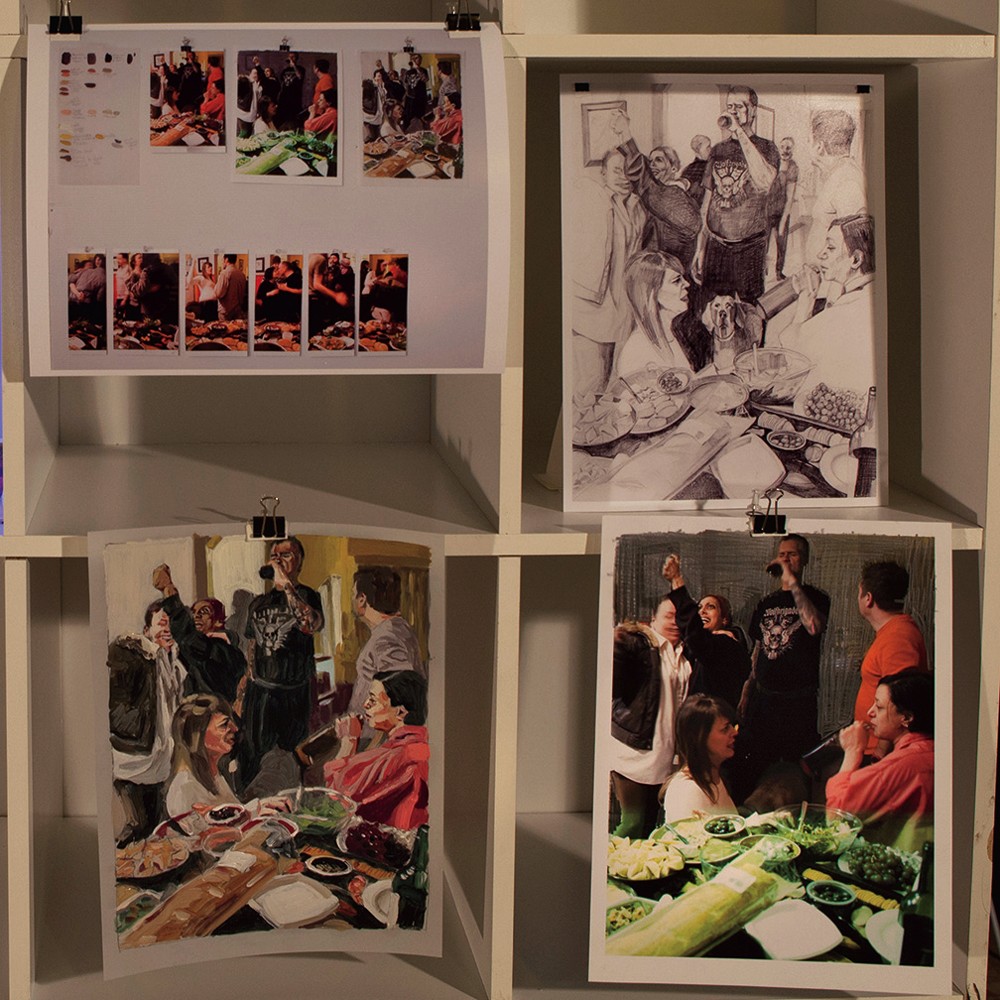Memory Redux
“Wake, Vicki,” a two-sided set of four stacked bookshelves, including drawings and objects, was installed for a One Night Stand organized by Colin Zipp on the evening of January 19th, 2015. This one was at The Tallest Poppy restaurant in Winnipeg. The sculpture was made and drawn by Lisa Wood as a tribute to her friend, Victoria Banner, who died in 2013.
“Wake, Vicki” was both a naming of an event and a metaphoric call to Vicki to come back to the place she loved and the place where she was loved. The content was generated from photographs taken at a memorial wake held a year after her death, where her husband invited friends to commemorate Vicki’s life. Wood wasn’t sure what the mood would be, so she set up a stationary camera behind the food table with a time-lapse shutter release taking a picture every 30 seconds for four hours. She ended up with thousands of pictures. “They were difficult to work with because I didn’t control the lighting, which was horrible, and the colour was crazy. There were so many things in the scene that as a painter, I would have edited out.”

Wake, Vicki, 2015, installation detail, edited source photographs, colour study, oil painting, graphite on photograph, photo documentation of graphite drawing, photograph of studio progress. Photographs: Karen Asher. All images courtesy the artist.
Wood worked for a year and a half figuring out how best to use the images, finally realizing that the paintings and drawings she made from the photographs were an important part of the process of documenting the wake. The piece she installed at The Tallest Poppy includes paraphernalia from her studio: colour charts, books, mugs, a can of paint, a number of drawings in various stages taken from the photographs, and a slogan, “Who gives a shit,” that was Vicki’s own. These objects sit in the cubicled shelves like relics.
Then she discovered a kind of drawing that echoed the photographic source in a rich way. She drew graphite portraits on indigo paper, and they looked like negatives. “I realized they carried a lot of mystery, and in changing the whole tone of their facial expressions the subjects ended up looking garish, almost frightening.” She pinned 15 of these negative drawings onto the back of the installation; 14 were portraits and one was a blank sheet, a stand-in for Vicki’s absence.

Embrace 2, 2014, graphite on paper, 8.5 x 11 inches.
The drawings did more than record people who were at the wake. As you walked by them, the faces would disappear. Suddenly their documented presence was also a prophecy of their own mortality, a kind of memento mori remembered in advance of death. It was a recognition not lost on Wood. “I thought about the idea of ghosts and about how temporal everything is. It was a wakeup call about control, and how the direction we want to have over our lives can change so completely.”

Wake, Vicki, 2015 installation of photographs, drawings, paintings, studio ephemera and iPad on 6’ x 6’ cube shelving unit.
Wood admits that everything has a double meaning for her. The piece does double duty in the way that it plugs so thoroughly into the complexities of the way we remember. The wake itself is a vehicle for remembering, and through her activity in the studio it is given another life. “Wake, Vicki,” then, is the memory of a memory. It makes it hard to forget. ❚

Wake, Vicki, 2015 installation of 15 graphite portraits on opposite side of 6’ x 6’ shelving unit.

